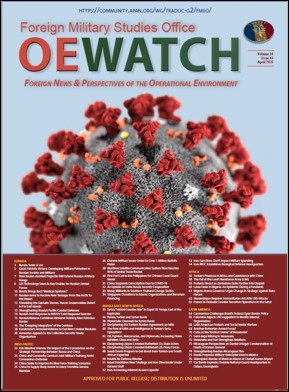
OE Watch, Vol. 10 (Iss. 04)
As Russia gears up to celebrate the 75th anniversary of its “Great Patriotic War” in May, efforts to develop a state ideology based on “military patriotism” are apparent (“Great Patriotic Victory: Developing Military Patriotism in Russian Society and Military”). The April issue of OE Watch also continues to look at the Russian military’s improved combat capabilities (“Russia: Tanks A Lot”; “New Rocket-Assisted Projectile Will Extend Russian Artillery Range”; “GIS Technology Seen As Key Enabler for Russian Armed Forces”) and upgrades to its military equipment in the Far East (“Shredding the Sakhalin Shores: Recon Snowmobiles Debut in the Far East Islands”; “Strengthening Russia’s Pacific Coastal Defenses”). One article highlights Russia’s plans to re-introduce the special-purpose medical detachments (SPMD) or “medical-spetsnaz” back into the Russian Armed Forces (“Russia Brings Back ‘Medical Spetsnaz'”).
The Indo-Pacific section considers the impact of COVID-19 on China’s relationship with Russia (“Fair-Weather Friends: The Impact of the Coronavirus on the Strategic Partnership Between Russia and China”) as well as on its military conscription system (“China Suspends Conscription Due to COVID-19”). China continues to strive for more realistic training scenarios (“China Seeks to Improve its Blue Force Training Scenarios”) and this also entails improving body armor for its service members, to be used in training (“China to Supply Body Armor to Every Frontline Service Member”).
The Middle East/North Africa section contains multiple, regional articles covering the dynamics of the conflicts in Libya and Syria. Libya has emerged as a complex battlefield with a multitude of stakeholders and their proxies. Three articles lay out the various dimensions of the operational environment in Libya through different perspectives (“Deciphering Libya’s Crowded Battlefield (1): State Actors”; “Deciphering Libya’s Crowded Battlefield (2): Proxy Forces”; “Oil, Figthers, Mercenaries and Diplomats: Increasing Flows Between Libya and Syria”). In Syria, relations between Turkey and Russia are highlighted (“Russia, Turkey and Syrian Kurds”; “Deciphering the Turkish-Russian Agreement on Idlib”) as well as insights to Turkey’s use of UAVs (“The Role of UAVs and Intelligence in Turkey’s Syria Operations”).
In the Africa section, COVID-19’s impact on Nigeria is considered, especially as the country tries to deal with Lassa Fever (“Lassa Fever in Nigeria: An Epidemic During a Pandemic”). In Latin America, Brazil grapples with the question of whether to end its federal open border policy (“Coronavirus Challenges Brazil’s Federal Open Door Policy”).
This issue of OE Watch features 57 articles covering various security challenges from the foreign perspective from over thirty different countries and regions around the globe. It can be found at FMSO’s website: https://community.apan.org/wg/tradoc-g2/fmso/. All of FMSO’s books, studies, and OE Watch issues are there.
This particular issue can be downloaded directly at https://community.apan.org/wg/tradoc-g2/fmso/m/oe-watch-past-issues/323591/download.
For more information on this product, please contact: Mr. Paul (Kent) Baumann, paul.k.baumann2.civ@mail.mil, Foreign Military Studies Office, Fort Leavenworth, KS
Recent Posts
The 2S35 Koalitsiya-SV, Robotics and the Future of Russian Artillery Modernization
Read the Full Article: https://www.canada.ca/en/army/services/canadian-army-journal/articles/2024/20-2-grau-and-bartles-russian-artillery-modernization.html
M-DIME | Russian military influence in Mali
What tools of national power does Russia use to gain…
M-DIME | Instruments of Russian Military Influence in Burkina Faso
What tools of national power does Russia use to gain…
